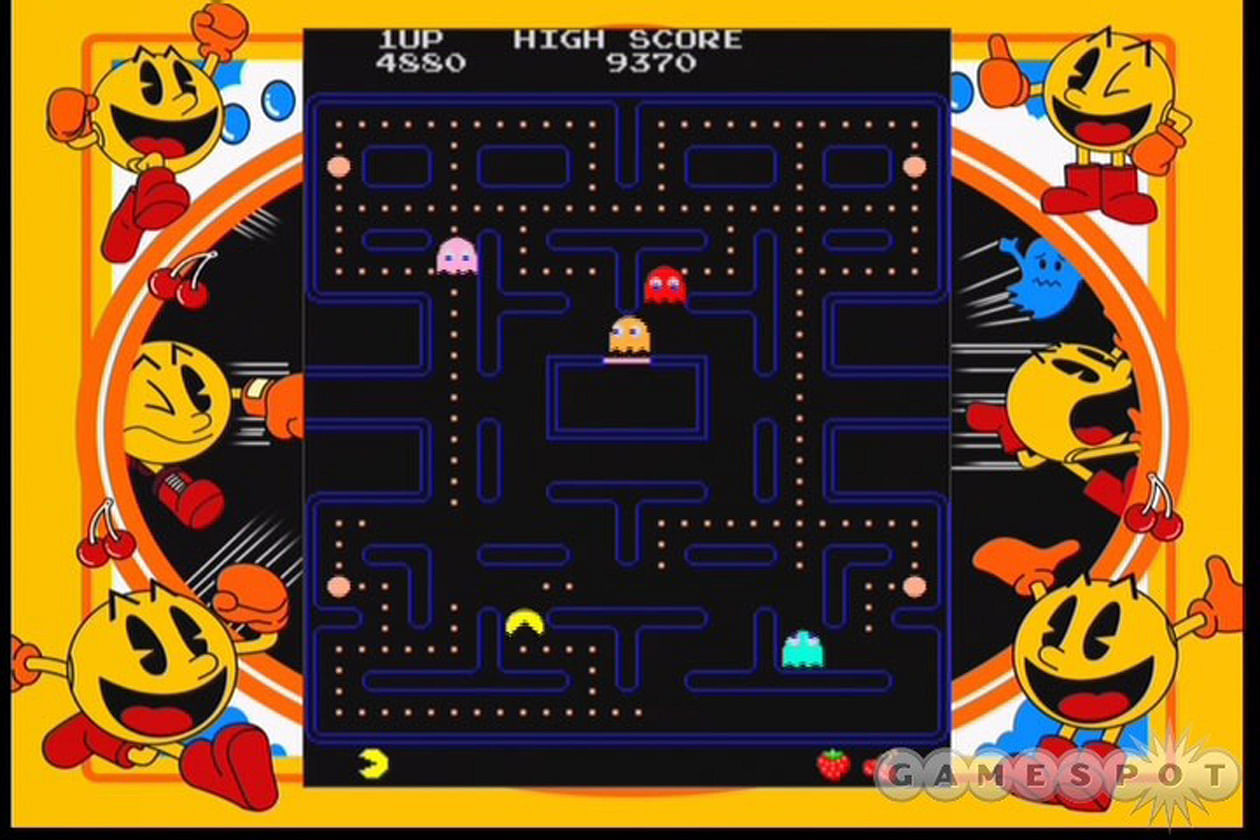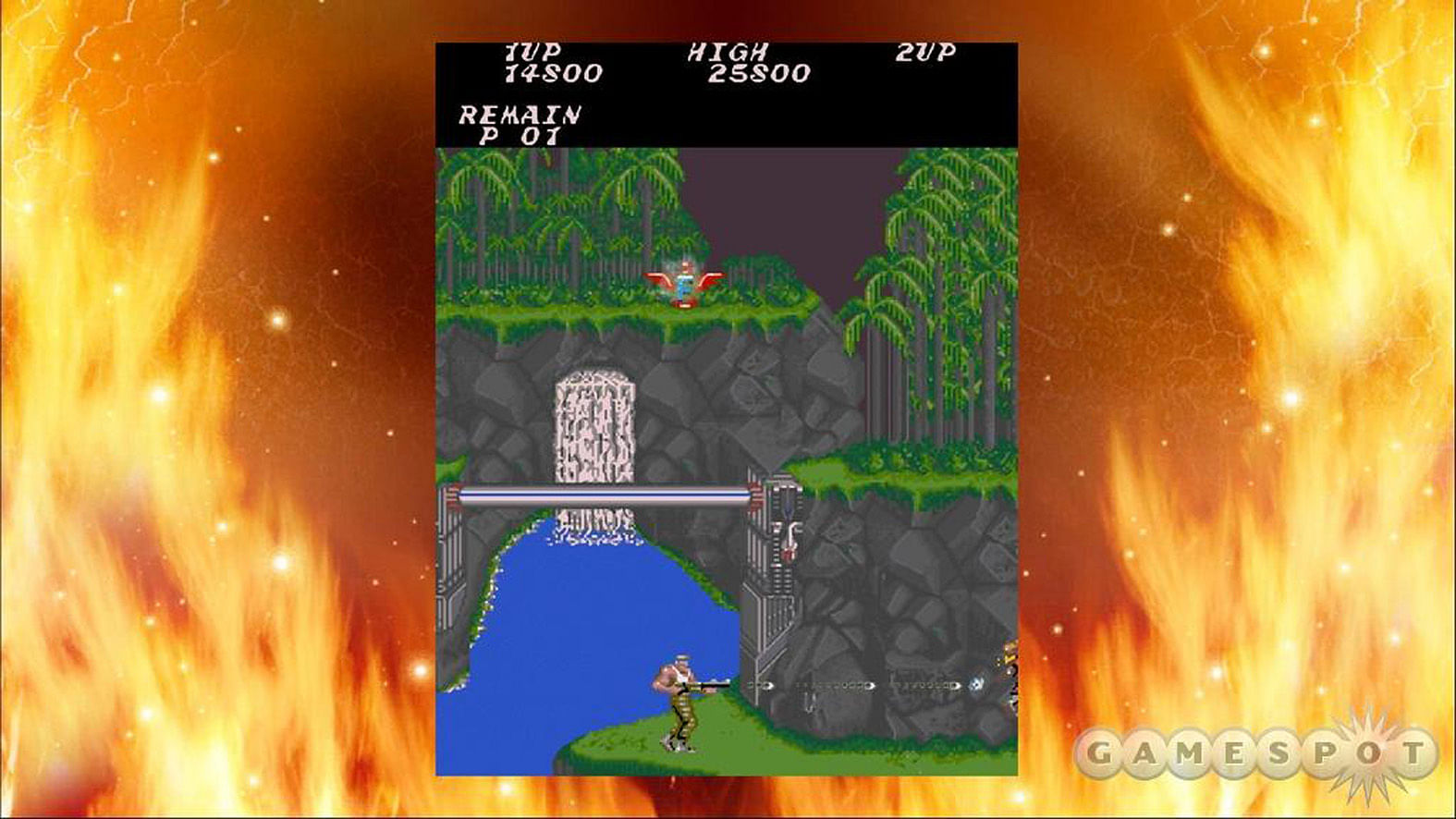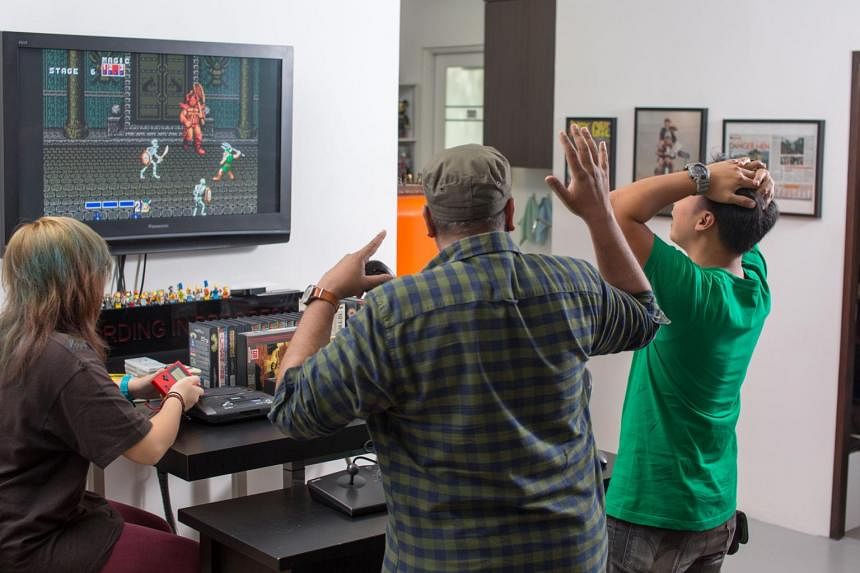At indie video gaming hub Versus City, grown men sit in front of a row of arcade machines, their eyes transfixed by the bright screens on which they battle a dozen virtual enemies.
With one hand, their fingers pound furiously on the colourful buttons, while the other hand deftly manoeuvres a joystick.
They do not play on sleek Sony PlayStation 4 or Microsoft Xbox consoles, nor do the games come with state-of-the-art graphics and smart interfaces.
Instead, these retro gamers, as they are known, get their gaming fix from vintage arcade, console and personal computer video games, which are usually based on original hardware that is no longer in production.
These include cartridge-based machines from the the late 1970s, 1980s and the 1990s such as the Atari 2600, Sega Mega Drive, Nintendo Entertainment System (NES), Super Nintendo Entertainment System (SNES) and the Neo Geo.
Most of these retro games and consoles cannot be bought from brick-and-mortar video game stores in Singapore as they stock only modern and the latest merchandise. But they are available through the resale market, including home-grown mobile app marketplace Carousell or online game marketplace GameTrader.SG.
A check on Carousell shows there are around 26,000 listings of retro gaming merchandise, and close to 10,000 items have been sold.
GameTrader.SG tells Life! that around 100 users have been selling retro games and consoles on the site since 2012, with 128 items sold so far.
For example, a second-hand Super Family Computer (Famicon) console - the Japanese version of the Super Nintendo Entertainment System - with two original games is going on Carousell at $120, while a first-version Sega Mega Drive bought in 1992 is selling at $200. Retrocartridges and games are generally priced between $6 and $70 on the site.
With more people becoming interested in things of the past, video games are jumping in on a retro trend already embraced by furniture shops and cafes, though the group of retro gamers in Singapore is still small and niche.
Retro gaming is big in other parts of the world. Both Japan and Hong Kong have electronic stores that specialise in selling retro games, while annual retro gaming conventions are held in the United States and United Kingdom.
Also hitting the cinemas in August is science- fiction action-comedy Pixels, starring Adam Sandler, which tells of Earth being attacked by classic video game characters such as the yellow pellet-gobbling Pac-Man, Donkey Kong the gorilla and Space Invaders.
Mr Lenn Yang, owner of Versus City, says his customers are generally between 25 and 40 years old, and many of them still hold fond memories of the video games they grew up playing. Versus City, which opened in 2013, is the only place here to offer retro arcade games and gaming consoles. It started operations at its new premises in Woodlands last month after moving from Yio Chu Kang.
Mr Yang, 32, is planning to expand the new 1,200 sq ft unit to 1,500 sq ft by adding a mezzanine level in the next few months.
Versus City has 20 retro arcade machines, 12 retro video gaming consoles and more than 500 retro games, though not all have been set up yet. Popular arcade games available are Bubble Bobble (1986), Daytona USA (1994) and House Of The Dead (1996). It also offers modern games and 15 PC set-ups - the latter are available only early next month.
GameStart Asia 2014, a video gaming convention that started last year, is bringing back its popular retro gaming booth, Retro DNA, for its second edition in November. It tied up with Versus City last year to put together a section where visitors could play retro consoles, games and arcade machines from the 1980s, 1990s and early 2000s.
Last year, GameStart Asia attracted more than 12,000 people from 13 countries.
Ms Elicia Lee, 34, director of Eliphant Pte Ltd which organises GameStart Asia, says: "Retro DNA was extremely well-received and a crowd favourite. When we announced GameStart Asia 2015, many people asked us whether Retro DNA would be back."
Sequels of arcade classics such as the Mortal Kombat and Street Fighter series have been released in 3-D high definition for modern consoles, while popular retro games such as Pac-Man, Tetris and Bomberman are also available on mobile devices.
So what is the appeal of original retro games from the 8-bit and 16-bit eras, when 2-D pixel art graphics were the gold standard? (The 8-bit era began from 1983 with third-generation video games, and the 16-bit era started from 1987, with fourth- generation video games)
Mr Yang, who invested $130,000 in Versus City, says: "Retro games have a special place in my heart. Collecting them is a way to preserve the past I shared with my brothers and friends playing these games."
He still keeps his original Nintendo Entertainment System and Sega Mega Drive home consoles, both of which he obtained more than 25 years ago.
He says the arcade, which is open every Wednesday (5pm to 1am), Friday and Saturday (3pm to 1am), sees around 20 customers during peak hours. He charges an hourly rate of $4 or a day rate of $15.
Retro-gaming enthusiast Jerome Soh, 30, an assistant secretary at a law firm, recalls how he and his neighbours would challenge each other to mini-gaming competitions on the PlayStation 1, released in 1994 in Japan, when he was a teenager.
He says: "My neighbour would put his television set along the common corridor and we would gather around it and play video games."
Avid retro gamers tell Life! that the appeal in retro games also lies in their simplicity, compared to modern games that have become overly complex, often containing complicated backstories which take time to understand.
Design director Graeme Stephenson, 34, who hopped on the retrogaming bandwagon last year, says: "The old games have charm because you can just pick them up and play them on your own. But modern games are more about connecting with other people who are online, requiring more time and immersion."
Mr Yang says that old controllers came with only one directional pad and a maximum of two to four buttons.
"In the past, you did not have a lot of complex instructions where the enemy is programmed to have 10 different reactions to what you do. There were just one or two outcomes whenever you played a game," he adds.
The small community of retro gamers here hope to bring together more like-minded enthusiasts. Apart from meeting at Versus City, some have created online platforms to reach out to other enthusiasts.
For instance, public relations manager Jonathan Toyad, 32, started a YouTube channel discussing music from past and present video games, which include acoustic remixes of iconic game music such as the Sonic The Hedgehog theme song.
And Mr Soh has a series of podcasts on audio broadcast app Raur dedicated solely to retro games. Since January last year, he has also been selling retro games and consoles on Carousell, with the intention of getting to know more collectors. So far, he has sold over 300 retro gaming items.
He says: "Every year, I have a personal goal to get as many people as possible back to retro gaming. I want to let them know that in Singapore, we do have such a community. It may be very small but there are still people out there who collect and appreciate such old stuff," he says.
Mr Joe Peter, 36, who owns media production house No Average Joe, has set up a retro gaming corner in his office with his own collection of retro consoles and games for his younger colleagues to try out during breaks.
He says: "It's ambitious to expect the young to be interested in these retro games, but it is important that they know the history behind them in order to appreciate the now."
His collection includes handheld devices such as the first-generation Nintendo Game Boy which has no backlight. "A good game will always be a good game. It transcends time," he adds.
These sentiments are what senior system specialist Tan Joo Kuan, 44, hopes to impart to his 16-year-old son Kenneth, who has played retro game Super Mario Bros on their old consoles.
Mr Tan, who intends to pass down his treasured collection to his son, says: "Retro games are simple games but they have good game play and the replay value is high. They can be as fun as new games and I want him to know that."
In the last three years, he has spent about $7,000 on more than 300 second-hand retro games and 20 retro consoles, many of which he had sold off in his youth, to rebuild his original collection.
His son says: "I am the only one among my friends who has the opportunity to play these retro games."
How do mainstream gamers, especially the younger ones who started out on the later generations of game consoles such as the Xbox, PlayStation 3 and 4, and Nintendo Wii, view retro gaming?
Mr Toyad says with a chuckle: "My other gaming friends respect it, though they think I'm a bit weird sometimes. But it doesn't matter. I think I'm kind of weird too as my fascination with it can borderline on a bit obsessive."
But not all gamers are keen to try retro games.
Mr Clemence Yeo, 21, who is waiting to enter university and plays online battle arena game DotA 2 daily, says: "I'm attracted to modern-day gaming because of the high-end graphics. Games now are like movies, where everything is interactive and the high-definition environment is nice to look at.
"Retro games do not have that."
ICONIC RETRO VIDEO GAMES

Pac-Man
This yellow, pellet-gobbling character has become one of the most recognisable pop culture icons today. Released in 1980 by Namco, this arcade video game celebrated its 35th anniversary last month.
Pac-Man provided a refreshing change from the violent shoot 'em up arcade games of the 1980s. Players have to navigate Pac-Man around a maze and eat all the dots before progressing to the next stage.
Beware the game's colourful hungry ghost villains - Blinky, Pinky, Inky and Clyde - who are out to catch him.

Super Mario Bros
Plumbers Mario and Luigi are the adorable brothers who go on a mission to save the hapless Princess Peach from the evil Bowser.
This best-selling platform game was released on the Nintendo Entertainment System in 1985 and was the successor to the arcade video game Mario Bros. In the game, Mario scrambles after scattered coins to gain points, jumps on enemies and slips into pipes.
Look out for the coveted magic mushrooms, which helps him double in size and grow more powerful. His brother Luigi is available only in the game's multiplayer mode.
The Super Mario Brothers and other characters still star in modern versions of Nintendo games.

Street Fighter II: The World Warrior
This is the 1991 sequel to the blockbuster competitive fighting game series, first released as an arcade game in 1987.
Pick from eight characters with special attack modes, from Japanese martial arts expert Ryu to tough Chinese female fighter Chun-Li.
Players battle it out with opponents in different arenas and must diminish the other's vitality before the timer runs out. The one who takes two out of three matches wins.

Contra
This popular run-and-gun military combat game was developed by Konami and released in 1987 as an arcade game. Featuring side-scrolling levels, it has two commandos armed with default rifles who blast their way through hordes of soldiers and aliens in their path. Power-ups allow players to upgrade to more powerful weapons such as laser guns.
Every stage has a new end-boss (a powerful enemy in video games), who has to be defeated in order for the player to move on to the next stage.

Tetris
This classic brainteaser block-stacking game was developed in Russia and released in 1984.
In this simple yet challenging game, the player has to move and rotate descending multi-coloured geometric shapes so that they fit neatly in a horizontal row before they reach the bottom of the screen.
Once a line is completely filled with blocks, it disappears. If the shapes are not arranged and empty spaces appear, the screen is soon filled and the game ends.




